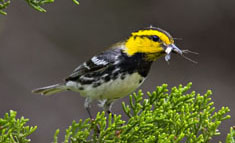 I rather suspect that no songbird has ever been the subject of a Sesquicentennial Celebration, but it seems very appropriate to celebrate the discovery of one of our cornerstone species at the Refuge, and to offer as my first substantive contribution to these "Notes from the Canyonlands" a review of that discovery.
I rather suspect that no songbird has ever been the subject of a Sesquicentennial Celebration, but it seems very appropriate to celebrate the discovery of one of our cornerstone species at the Refuge, and to offer as my first substantive contribution to these "Notes from the Canyonlands" a review of that discovery.
(Golden-cheeked Warbler photos by Greg W. Lasley; used by permission.)
Who first encountered a Golden-cheeked Warbler? I have to believe that some curious, observant Tonkawan youth[1], encamped near a headwater spring in a rugged canyon of the Edwards Plateau, would have noticed by sight or sound the bright little black and yellow bird singing from the top of a nearby juniper some March or April morning.
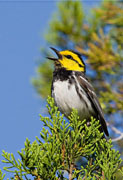
He or she probably realized the tiny creature wouldn't make much of a meal, nor could they fashion much of a headdress or other ornamentation out of its feathers. But we do presume that native Americans were well-tuned to details of their surroundings. Did the Tonkawa, analogous to my musings in Ro Wauer's book on the "Heralds of Spring"[2], recognize the Golden-cheek as a signal of the changing seasons? Despite what we have learned to date about the haunts and habits of those early inhabitants of what would later become Texas, it is a tragedy of history that we have no record of such detections.
The first Golden-cheeked Warblers in recorded history were encountered by an English naturalist in Central America, on the species' winter range. On November 4, 1859,
Osbert Salvin was riding on
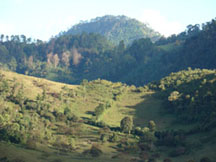
horseback over a wooded tropical ridge en route to the village of
Tactic, in the Guatemalan province of Alta Vera Paz, where he intended to spend the evening. He mentions that "
two birds attracted my attention, and I secured both. They, on examination at home, proved to belong to an undescribed species."[3] He and his colleague Philip Sclater described the species new to science the next year in the Proceedings of the Zoological Society of London[4].
Osbert Salvin (1835-1898) had received his education at Cambridge University. Soon after graduation, he made several exploratory journeys to collect biological specimens, including trips to North Africa and Central America. The 1859 expedition was his first visit to Guatemala. Salvin is not well-known in North America except to a small handful of researchers who may have studied the 19th Century history of biological exploration in Middle America. Nonetheless, his explorations, collections, and publications were very substantial, including his editorial role in the encyclopedic
Biologia Centrali-Americana, with Frederick D. Godman. They were sufficiently appreciated in Great Britain to garner for him membership in the prestigious
Royal Society of London. A nomination to the Royal Society needed to be accompanied by a write-up of the nominee's accomplishments and a collection of signatures of existing members who would provide witness to the worthiness of the candidate. Among others, signatories on the nomination of Osbert Salvin included:
Thomas H. Huxley - known as "Darwin's Bulldog" and a staunch defender of evolution.
John Gould - a collaborator with Charles Darwin and the namesake for perhaps the gaudiest bird in the world, the
Gouldian Finch.
Richard Owen - eminent paleontologist; described
Archaeopteryx and many dinosaur species.
Charles Darwin - This might be the equivalent of me, in my application to join the Texas Ornithological Society, gaining the endoresement of perhaps Roger Tory Peterson or Carl Sagan.
Even as Osbert Salvin was exploring Guatemala, major rumblings were afoot back in London. On November 24, 1859, just three weeks after Salvin collected those Guatemalan Golden-cheeks, Charles Darwin published the first edition of
The Origin of Species [5], another sesquicentennial being celebrated this year. To be sure, the short note by Sclater and Salvin in 1860 was not earth-shaking news and they may be forgiven if their brief three-page note was over-shadowed in the scientific literature of the time! Nonetheless, among the other interesting neotropical species described new to science in their article were the
Ruddy Crake,
Brown-hooded Parrot,
Russet Antshrike,
Stub-tailed Spadebill,
Yellow-bellied Tyrannulet,
White-lored Gnatcatcher and Brown Schiffornis. I have had the opportunity to see some of these species in Central America, but I can't say that I'd recognize a Brown Schiffornis if it bit me in the binocs! (see below)
New to science and collected far across "The Pond", the Golden-cheeked Warbler remained poorly known for several years after its discovery. There was considerable confusion in those early years since the plumages of the various ages and sexes of the related Black-throated Green, Townsend's and Hermit Warblers were still being sorted out. The mis-identifications and re-identifications of these
Dendroica warblers in some of that earliest literature at times reads like an ornithological version of the comedy routine
"Who's On First?" by
Abbott and Costello.
In a future entry, I'll talk about the discovery of the Golden-cheeked Warbler closer to home--here in Texas!
Footnotes and Further Reading: Note 1: I include external links from a variety of sources, with no particular rhyme or reason--just whatever strikes me as particularly useful for a given tidbit. I gravitate towards .org, .edu, and .gov sites where available. No endorsement of any particular website, organization, company, product, etc., is intended. They are included here for educational purposes only.
Note 2: This blog entry is based in part on my presentation of "The Origin and Discovery of the Golden-cheeked Warbler", delivered to the Highland Lakes Birding & Wildflower Society, at Marble Falls, Texas, September 3, 2009.
Note 3: A collection of much of the early literature on the Golden-cheeked Warbler is maintained in a couple of repositories in the Austin area including at the HQ of Balcones Canyonlands NWR and at the offices of the City of Austin's Balcones Canyonland Preserves.[1] See
this map for the home ranges of early Native Americans in Texas and the possible candidate tribes for the earliest warbler-watchers!
[2] Ro Wauer,
Heralds of Spring in Texas, Texas A&M Univ. Press, College Station (1999), pp. 164-169.
[3] Osbert Salvin. 1876.
Dendroica chrysoparia (The Yellow-cheeked Warbler). Pp. 181-184,
In: George D. Rowley (ed.).
Ornithological Miscellany, Vol. I, part III. Trubner and Co., Ludgate Hill, E.C., London.
[4] Philip L. Sclater and Osbert Salvin. 1860. Character of eleven new species of birds discovered by Osbert Salvin in Guatemala. Proc. Zool. Soc. London 28:298-301.
[5] See an excellent discussion of the publication of
The Origin of Species on Wikipedia at:
http://en.wikipedia.org/wiki/Publication_of_Darwin's_theory.* * * * *
Speaking of old dudes...If anyone was curious, that picture at the bottom of my first blog page (Oct. 28) is my handsome great-great grandfather Sexton, illustrating two things: (a) what I look like on a bad hair day, and (b) what my wife has to look forward to in another 25 years or so. Here's a more recent picture of me, in typical habitat, flanked by a Brown Schiffornis, a.k.a. Thrush-like Mourner or Manakin.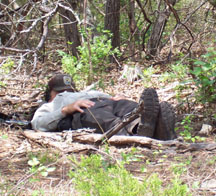
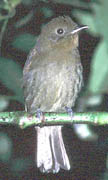 (My thanks to Kelly Barr (L) and Greg W. Lasley (R) for these pics.)
(My thanks to Kelly Barr (L) and Greg W. Lasley (R) for these pics.)
